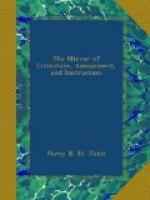Sheppey.—The isle of Sheppey is quickly giving way to the sea, and if measures are not hereafter taken to remedy this, possibly in a century or two hence its name may be required to be obliterated from the map. Whole acres, with houses upon them, have been carried away in a single storm, while clay shallows, sprinkled with sand and gravel, which stretch a full mile beyond the verge of the cliff, over which the sea now sweeps, demonstrate the original area of the island. From the blue clay of which these cliffs are composed may be culled out specimens of all the fishes, fruits, and trees, which abounded in Britain before the birth of Noah; and the traveller may consequently handle fish which swam, and fruit which grew, in the days of the antediluvians, all now converted into sound stone, by the petrifying qualities of the soil in which they are imbedded. Here are lobsters, crabs, and nautili, presenting almost the same reality as those we now see crawling and floating about; branches of trees, too, in as perfect order as when lopped from their parent stems; and trunks of them, twelve feet in length and two or three diameter, fit, in all appearance, for the operations of the saw, with great varieties of fruits, resembling more those of tropical climates than of cold latitudes like ours, one species having a large kernel, with an adherent stalk, as complete as when newly plucked from the tree that produced it. An interesting collection of these relics of a former world may be seen at a watchmaker’s on the cliff, at Margate, including the most remarkable productions of the isle of Sheppey.
The Camelopard.
[Illustration: The Camelopard.]
As a live camelopard has been sent to London and another to Paris, the history and habits of these animals have excited some interest. At a meeting of the Academy of Sciences in Paris, on the 2nd of July last, M. Geoffroy Saint-Hilaire observed that naturalists were wrong in supposing that there was only one species of the camelopard. The animal now in Paris differs from the Cape of Good Hope species by several essential anatomical characters, and he proposes to distinguish it by the name of the Giraffe of Sennaar, the country from which it comes. Some natives of Egypt having come to see the one in Paris in the costume of the country, the animal gave evident proofs of joy, and loaded them with caresses. This fact is explained by the circumstance that the Giraffe has an ardent affection for its Arabian keeper, and that it naturally is delighted with the sight of the turban and the costume of its keeper.




